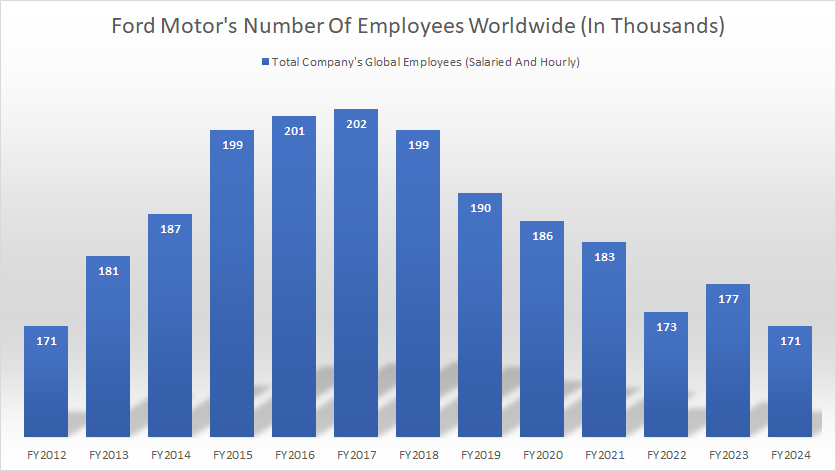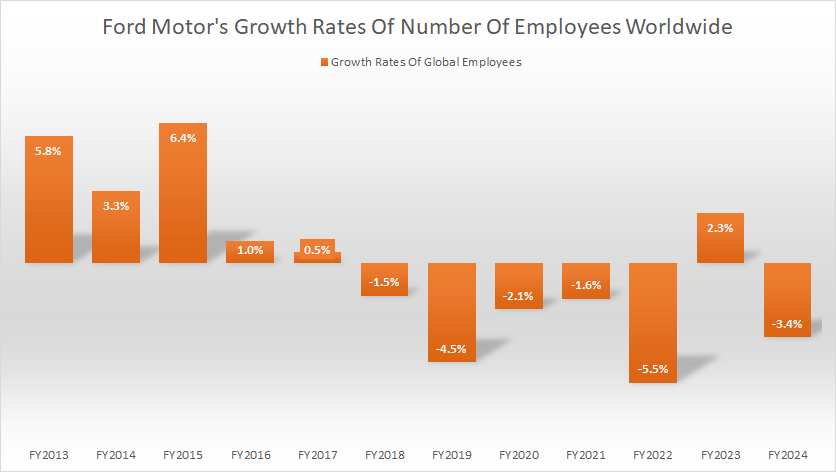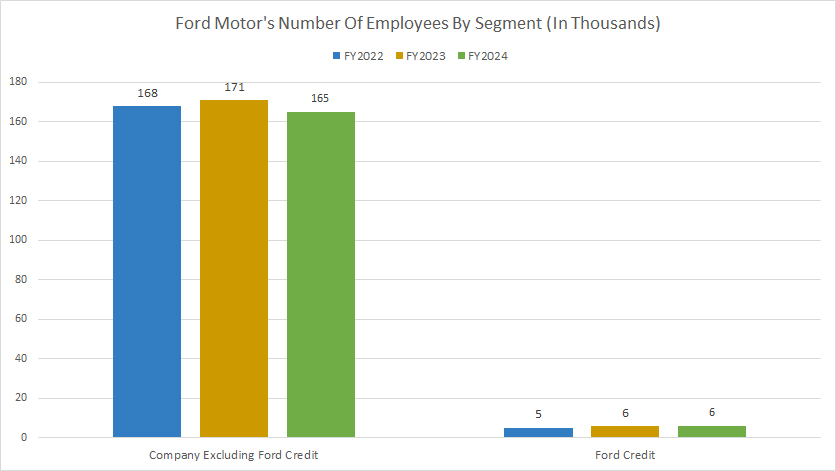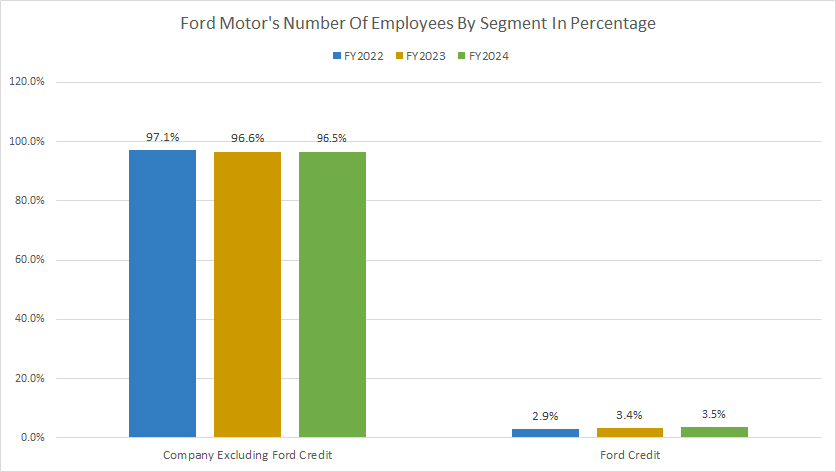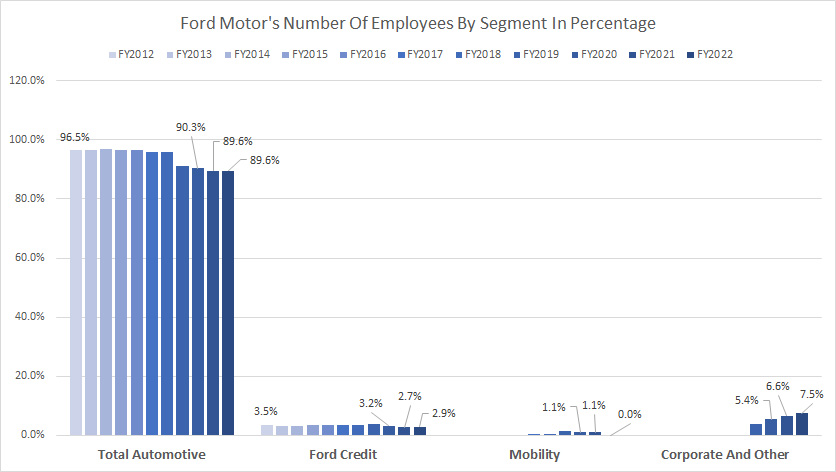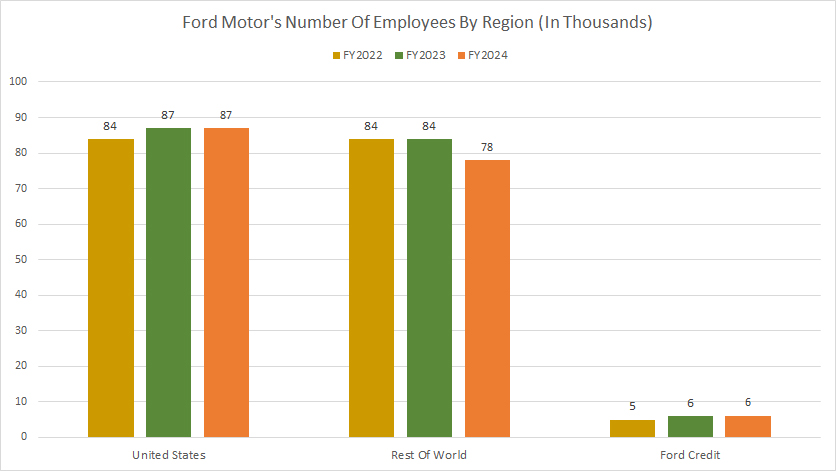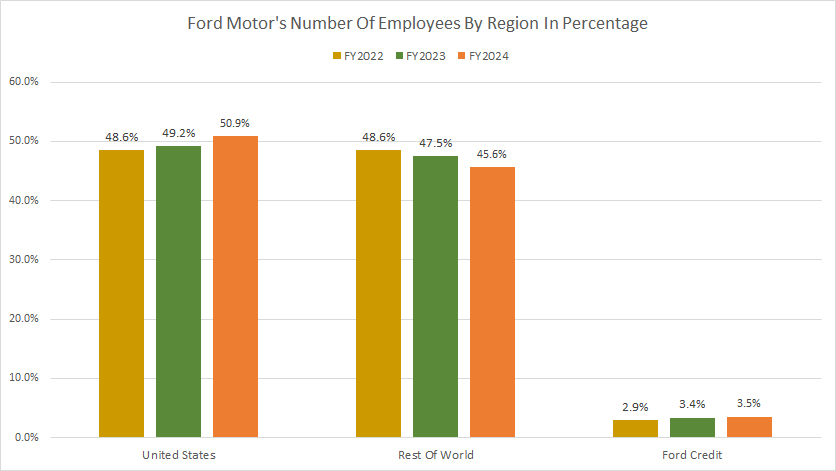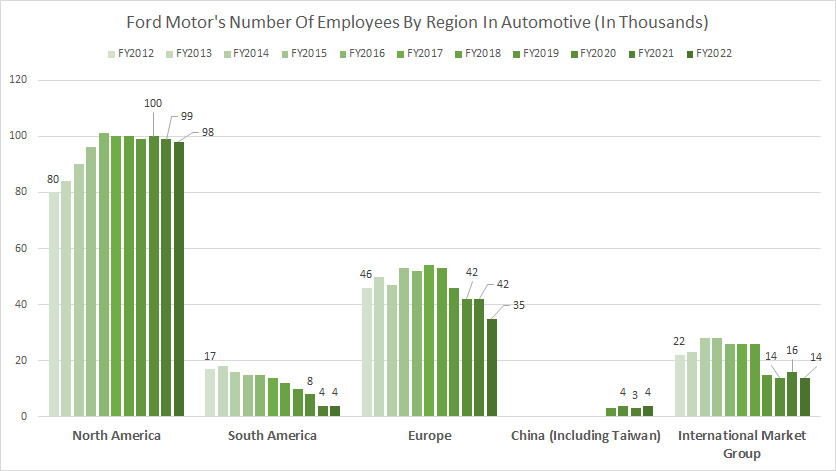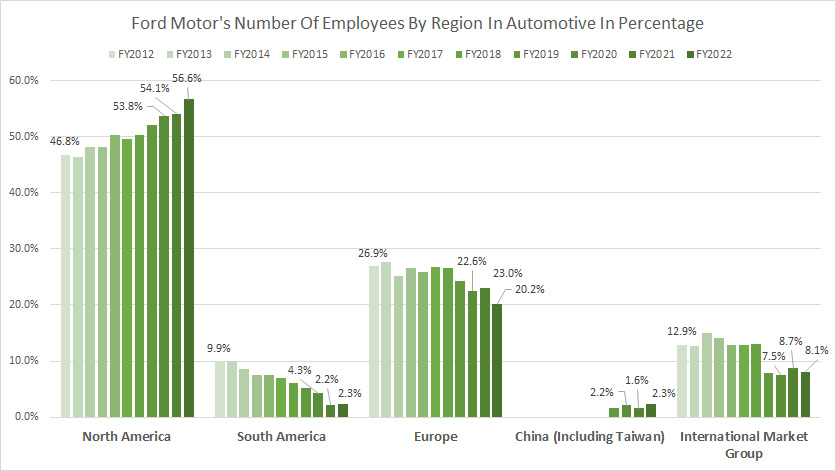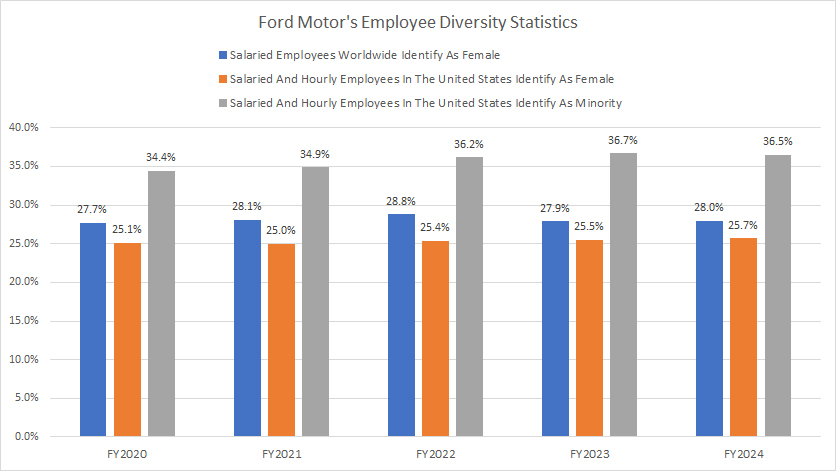
Workforce. Pixabay Image.
This article presents several statistics of Ford Motor Company’s employees. These statistics include the numbers of employees, employee by region and country, and employee by segment.
Apart from the employee statistics, we also explore Ford Motor’s diversity statistics, which include the percentage of salaried employees identify as female, and the percentage of salaried and hourly employees identify as minority.
Let’s get started.
For other key statistics of Ford Motor, you may find more information on these pages:
Retail Sales & Market Share
Wholesales
Revenue
- Revenue streams: sales of new and used cars, services, etc.,
- Revenue per employee in America, Europe, China, etc.,
- Revenue per car in North America, Europe, China, etc.,
Profit & Margin
Debt & Cash
Comparison With Peers
- Ford vs GM and Tesla: advertising and marketing budget,
- Ford vs General Motors: vehicle profit and margin,
- Ford vs Tesla: profit margin comparison,
Other Statistics
Please use the table of contents to navigate this page.
Table Of Contents
Definitions And Overview
O2. Is Ford Motor A Good Company To Work For?
Consolidated Results
A1. Total Employees
A2. Growth Rates Of Total Employees
Results By Segment (New)
B1. Employee Numbers By Segment
B2. Employee Numbers By Segment In Percentage
Results By Segment (Legacy)
B3. Employee Numbers By Segment
B4. Employee Numbers By Segment In Percentage
Results By Region (New)
C1. Employee Numbers By Region
C2. Employee Numbers By Region In Percentage
Results By Region (Legacy)
C3. Employee Numbers By Region
C4. Employee Numbers By Region In Percentage
Workplace Diversity
D1. Employee Diversity Statistics
Conclusion And Reference
S1. Insight
S2. References and Credits
S3. Disclosure
Definitions
To help readers understand the content better, the following terms and glossaries have been provided.
Workplace Diversity: Workplace diversity refers to the practice of including and integrating a wide range of diverse individuals in an organizational setting. This diversity can span various dimensions, including but not limited to race, ethnicity, gender, age, sexual orientation, physical abilities, religious beliefs, socioeconomic status, education, national origin, and political beliefs.
The concept goes beyond mere compliance with laws that prohibit discrimination; it’s about fostering an inclusive environment where the differences and uniqueness of each employee are valued, respected, and leveraged for the benefit of the organization.
A diverse workplace aims to reflect the variety of identities and experiences found in broader society, believing that a multitude of perspectives can lead to more innovative solutions, better decision-making, and a more competitive organization overall.
It also seeks to ensure equal opportunities for all employees to contribute and advance within the company. Embracing diversity can enhance employee satisfaction, improve team dynamics, and boost the company’s reputation among potential employees and customers.
Is Ford Motor A Good Company To Work For?
Ford Motor Company, as an employer, has several aspects that might appeal to prospective employees. The company is one of the oldest automotive manufacturers in the world, offering a deep history and a strong brand reputation. Ford is known for its commitment to innovation, especially with its investments in electric vehicles and sustainable technologies, which could provide exciting opportunities for those interested in these fields.
Working at Ford can offer various benefits, including competitive salaries, health benefits, retirement plans, and opportunities for career advancement and professional development. Ford also emphasizes a diverse and inclusive work environment, supporting various employee resource groups.
However, like any large corporation, experiences can vary greatly depending on the specific role, department, and location. Some employees report high levels of job satisfaction and commend the company for its culture and management practices. Others may point out challenges such as work-life balance or bureaucratic hurdles typical of large organizations.
To determine if Ford is a good company, consider your career goals, desired work environment, and the specific job role you are considering. Researching current and former employee reviews on platforms like Glassdoor or LinkedIn can provide further insights into what working at Ford is like. Additionally, reaching out to current employees or attending company events can offer valuable firsthand perspectives.
Total Employees
ford-motor-number-of-global-employees
(click image to expand)
Ford Motor’s number of employees worldwide reached a record low of 171,000 as of the end of fiscal year 2024, a decrease of 3% over 2023, as stated in Ford’s 2024 annual report.
Ford Motor’s global workforce peaked at over 200,000 in fiscal year 2017. Since then, it has been been on the decline, reaching just 171,000 employees in the latest result, a level last seen in 2012.
Since 2017, Ford’s total workforce, which include salaried and hourly workers, has decreased by 15%.
Growth Rates Of Total Employees
ford-motor-growth-rates-of-number-of-global-employees
(click image to expand)
The growth rate plot above shows that Ford’s total employees has been in a decline in most of the periods shown.
On average, Ford’s total workers have experienced a decline of 2.1% per year over the last five years since 2020.
As of 2024, Ford’s worldwide employees declined by 3.4% over 2023, a much higher rate than the 5-year average of 2.1%.
Employee Numbers By Segment (New)
ford-motor-number-of-employees-by-segment-new-reporting
(click image to expand)
Ford has reorganized its business segment in 2023. This section of reporting is a new format and has started since 2023.
For the legacy segments, you may visit this section: employee numbers by segment (legacy).
That said, the majority of Ford’s employees are concentrated in Company Excluding Ford Credit. The employee number in this segment reached 165 thousand as of the end of 2024, down significantly from 171 thousand reported in 2023.
On the other hand, Ford Credit employed just 6 thousand workers in fiscal year 2024, which was the same as the result in 2023.
Employee Numbers By Segment In Percentage (New)
ford-motor-number-of-employees-by-segment-in-percentage-new-reporting
(click image to expand)
Ford has reorganized its business segment in 2023. This section of reporting is a new format and has started since 2023.
For the legacy segments, you may visit this section: employee numbers by segment (legacy).
Ford’s employees in Company Excluding Ford Credit has accounted for the majority of the total workforce, reaching 96.5% in fiscal year 2024.
On the other hand, Ford’s employees in Ford Credit has accounted for only a minority of the total workforce, with the ratio totaling just 3.5% in fiscal year 2024.
Employee Numbers By Segment (Legacy)
ford-motor-number-of-employees-by-segment
(click image to expand)
Ford has reorganized its business segment in 2023. Therefore, this section of reporting is no longer available starting in 2023 and is considered a legacy report. I still keep the data for reference in case anyone is interested.
Ford’s automotive segment has employed the highest number of employees in all fiscal years.
The number of employees employed in the automotive segment totaled 155,000 in fiscal year 2022, which was way more than any number of employees in other segments.
Ford’s Corporate And Other had the second highest number of employees, notably at 13,000 in fiscal year 2022.
Ford Credit had roughly 5,000 employees in fiscal year 2022 while Mobility had none in the same period due to divestiture of the segment.
A noticeable trend is the significant decline of Ford Motor’s employees in the automotive segment, which has dropped from nearly 200 thousand at its peak to just 155 thousand in fiscal year 2022.
Employee Numbers By Segment In Percentage (Legacy)
ford-motor-number-of-employees-by-segment-in-percentage
(click image to expand)
Ford has reorganized its business segment in 2023. Therefore, this section of reporting is no longer available starting in 2023 and is considered a legacy report. I still keep the data for reference in case anyone is interested.
Ford Motor’s number of employees in the automotive segment accounted for 89.6% of the total workforce in fiscal year 2022. This ratio has decreased considerably, from 96.5% in 2012 to 89.6% in 2022.
The percentage of Ford’s employees in Ford Credit accounted for only 2.9% of the total workforce in fiscal 2022, while Corporate And Other formed 7.5%.
Although the percentage of Ford’s employees in the automotive segment had considerably declined, it was still the segment that had the biggest workforce in fiscal year 2022.
Employee Numbers By Region (New)
ford-motor-number-of-employees-by-region-new-reporting
(click image to expand)
Ford presents only the employees in the U.S. and Rest of World starting in 2023. Therefore, this section of reporting is a new format and has started since 2023. For the legacy reporting, you may visit this section: employee numbers by region (legacy).
Ford employed approximately 87 thousand workers (salaried and hourly) in the U.S. in fiscal year 2024, inline with the number in 2023.
For the Rest Of World region, Ford employed significantly fewer employeescompared to the U.S. workplaces, totaling 78 thousand by the end of the fiscal year 2024. This figure was down modestly from the 84 thousand in 2023.
Employee Numbers By Region In Percentage (New)
ford-motor-number-of-employees-by-region-in-percentage-new-reporting
(click image to expand)
Ford presents only the employees in the U.S. and Rest of World starting in 2023. Therefore, this section of reporting is a new format and has started since 2023. For the legacy reporting, you may visit this section: employee numbers by region (legacy).
Ford’s total workforce in the U.S. and Rest Of World has accounted for roughly the same percentage, totaling 50.9% and 45.6%, respeectively, in fiscal year 2024. These ratios were changed significantly from the results in 2023.
The remaining percentage is made up by Ford Credit, totaling 3.5% as of 2024.
Employee Numbers By Region (Legacy)
ford-motor-number-of-employees-by-region
(click image to expand)
Ford has no longer broken down its employees by region starting in 2023. Therefore, this section of reporting is no longer available starting in 2023 and is considered a legacy report. I still keep the data for reference in case anyone is interested.
Ford had the most number of employees in North America, reportedly at 98,000 in fiscal year 2022, according to the 2022 annual report. In 2020, the employee number in this region was slightly higher, totaling 100 thousand.
In contrast, Ford’s employees in South America have significantly decreased over the years, reaching just 4 thousand workers in fiscal year 2022 from 17 thousand in 2012 – a decrease of 76% in ten years.
Ford’s employees in Europe also has experienced a considerable reduction. As of fiscal year 2022, Ford’s number of workers in Europe reached 35 thousand, a decrease of 24% from the 46 thousand in 2012.
Ford’s employed just 4,000 workers in China as of fiscal 2022, the lowest among all regions, while total employees under the International Market Group (IMG) reached 14 thousand.
Employee Numbers By Region In Percentage (Legacy)
ford-motor-number-of-employees-by-region-in-percentage
(click image to expand)
Ford has no longer broken down its employees by region starting in 2023. Therefore, this section of reporting is no longer available starting in 2023 and is considered a legacy report. I still keep the data for reference in case anyone is interested.
Ford’s employees in North America has accounted for the majority of its workforce, totaling nearly 57% of the total as of fiscal 2022, the largest among all regions.
More importantly, the percentage of employees in North America has increased from 47% in fiscal 2012 to the latest 57% as of 2022. It is the only region that has seen a rise in the percentage.
On the other hand, Ford’s employees in South America accounted for only 2.3% of the company’s total workforce as of fiscal 2022, and this ratio was similar to that of China.
Ford’s employees in Europe also have experienced a similar decline in percentage and the number came in at 20.2% as of fiscal year 2022.
In short, Ford has experienced a significant decrease in the percentage of employees in the South America and Europe regions.
Employee Diversity Statistics
ford-motor-employee-diversity-statistics
(click image to expand)
The definition of workplace diversity is available here: workplace diversity.
Ford’s number of salaried employees worldwide identify as female totaled 28% of its global workforce in fiscal year 2024, according to the 2024 annual report. This ratio peaked at 28.8% in fiscal year 2022 but has remained relatively unchanged over the last four years.
In the U.S., Ford’s number of salaried and hourly workers identify as female made up about 25.7% of its total workforce in the U.S. as of fiscal year 2024, up slightly from the 25.1% in 2020.
On the other hand, 36.5% of Ford’s total workforce in the U.S. was identified as minority as of fiscal year 2024, up modestly from the 34.4% in 2020.
Insight
In short, Ford Motor’s total employees globally have considerably declined since reaching its peak figure of 200 thousand in 2017, with most of the decline coming from the automotive sector.
The most impacted regions with the largest employee reduction in percentage were South America and Europe. The workers in both regions have declined by 76% and 24%, respectively, between 2012 and 2022.
Ford employed approximately 100 thousand workers in North America. This figure decreased to 98 thousand or 56.6% of its global workforce in fiscal year 2022. Ford had the most number of employees in North America. Europe came in second at 35 thousand or 20% of its total workforce in 2022.
The U.S. alone contributed to about 87 thousand workers or 49% of its global workforce in fiscal year 2023. Ford Motor employed only 4,000 people in China, with Taiwan included, in fisal year 2022, representing only 2.3% of the company’s total employees.
References and Credits
1. All financial figures presented were obtained and referenced from Ford’s quarterly and annual reports published on the company’s investor relations page: Ford shareholders page.
2. Pixabay Image.
Disclosure
We may use artificial intelligence (AI) tools to assist us in writing some of the text in this article. However, the data is directly obtained from original sources and meticulously cross-checked by our editors multiple times to ensure its accuracy and reliability.
If you find the information in this article helpful, please consider sharing it on social media. Additionally, providing a link back to this article from any website can help us create more content like this in the future.
Thank you for your support and engagement! Your involvement helps us continue to provide high-quality, reliable content.

